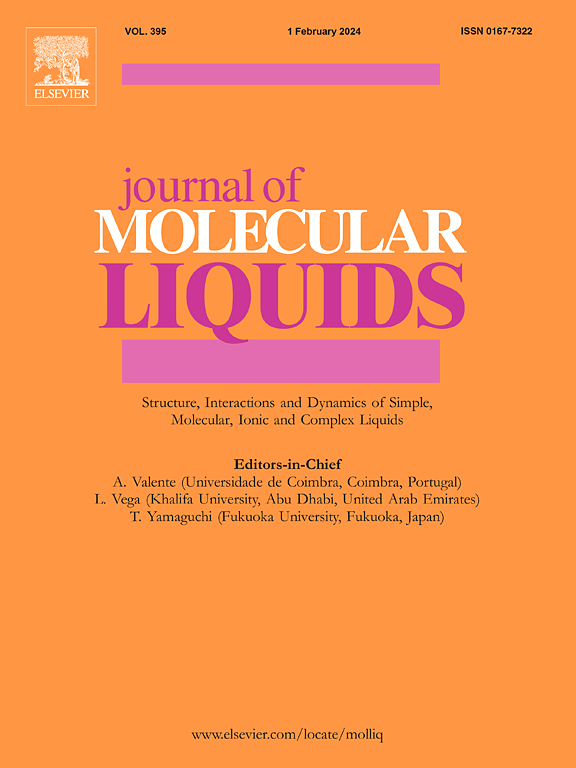相变酸对二氧化碳淹没的自我调节曲线控制策略
IF 5.3
2区 化学
Q2 CHEMISTRY, PHYSICAL
引用次数: 0
摘要
为解决二氧化碳淹没过程中气体通道导致的低扫描效率问题,我们设计了由十四碳二酸(TA)和聚丙二醇双(2-氨基丙基醚)(D230)组成的二氧化碳刺激响应液固转换系统(TA-D230)。TA 具有高熔点且不溶于水,通过与 D230 的自组装方法实现了从固相到液相的转变。注入二氧化碳后,TA 以固体形式从 TA-D230 溶液中析出。1H NMR 和傅立叶变换红外光谱证实了 TA-D230 转化为 TA 的机理,即 COO- 基团还原为 COOH 基团。经 DSC 测定,TA 的熔点高达 128 ℃,可用于高温储层。此外,通过记录注入二氧化碳时电导率和 pH 值的变化,0.1 mol/L TA-D230 在 5 分钟内和 5000 ppm 的 NaCl 溶液中实现了快速沉淀。岩心淹没实验进一步评估表明,TA-D230 具有出色的提高石油采收率的能力,采收率高达 15.3%。这种方法为油气开发中的剖面控制提供了新的视角和解决方案。本文章由计算机程序翻译,如有差异,请以英文原文为准。
Self-regulating profile control strategy for CO2 flooding by the phase-transition acid
To solve the problem of low sweep efficiency caused by gas channeling in CO2 flooding, the CO2 stimulated response liquid–solid transition system (TA-D230) was designed by the tetradecanedioic acid (TA) and poly(propylene glycol) bis(2-aminopropylether) (D230). TA, which has high melting point and is insoluble in water, achieves the transition from solid phase to liquid phase by the self-assembly method with D230. After CO2 injection, the TA was precipitated from TA-D230 solution as the solid. The transformation mechanism from TA-D230 to TA was confirmed by 1H NMR and FTIR due to the reduction of COO− group to COOH group. The TA exhibited a high melting point of 128 °C by the DSC, which can be applied in high temperature reservoirs. In addition, by recording the changes in conductivity and pH during the injection of CO2, 0.1 mol/L TA-D230 achieved rapid precipitation within 5 min and in a 5000 ppm NaCl solution. The core flooding experiment further assessed that TA-D230 has excellent ability to enhance oil recovery with a value of 15.3 %. This method provides a new perspective and solution for profile control in oil and gas development.
求助全文
通过发布文献求助,成功后即可免费获取论文全文。
去求助
来源期刊

Journal of Molecular Liquids
化学-物理:原子、分子和化学物理
CiteScore
10.30
自引率
16.70%
发文量
2597
审稿时长
78 days
期刊介绍:
The journal includes papers in the following areas:
– Simple organic liquids and mixtures
– Ionic liquids
– Surfactant solutions (including micelles and vesicles) and liquid interfaces
– Colloidal solutions and nanoparticles
– Thermotropic and lyotropic liquid crystals
– Ferrofluids
– Water, aqueous solutions and other hydrogen-bonded liquids
– Lubricants, polymer solutions and melts
– Molten metals and salts
– Phase transitions and critical phenomena in liquids and confined fluids
– Self assembly in complex liquids.– Biomolecules in solution
The emphasis is on the molecular (or microscopic) understanding of particular liquids or liquid systems, especially concerning structure, dynamics and intermolecular forces. The experimental techniques used may include:
– Conventional spectroscopy (mid-IR and far-IR, Raman, NMR, etc.)
– Non-linear optics and time resolved spectroscopy (psec, fsec, asec, ISRS, etc.)
– Light scattering (Rayleigh, Brillouin, PCS, etc.)
– Dielectric relaxation
– X-ray and neutron scattering and diffraction.
Experimental studies, computer simulations (MD or MC) and analytical theory will be considered for publication; papers just reporting experimental results that do not contribute to the understanding of the fundamentals of molecular and ionic liquids will not be accepted. Only papers of a non-routine nature and advancing the field will be considered for publication.
 求助内容:
求助内容: 应助结果提醒方式:
应助结果提醒方式:


